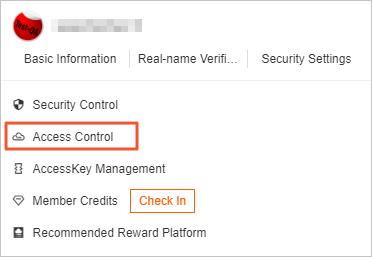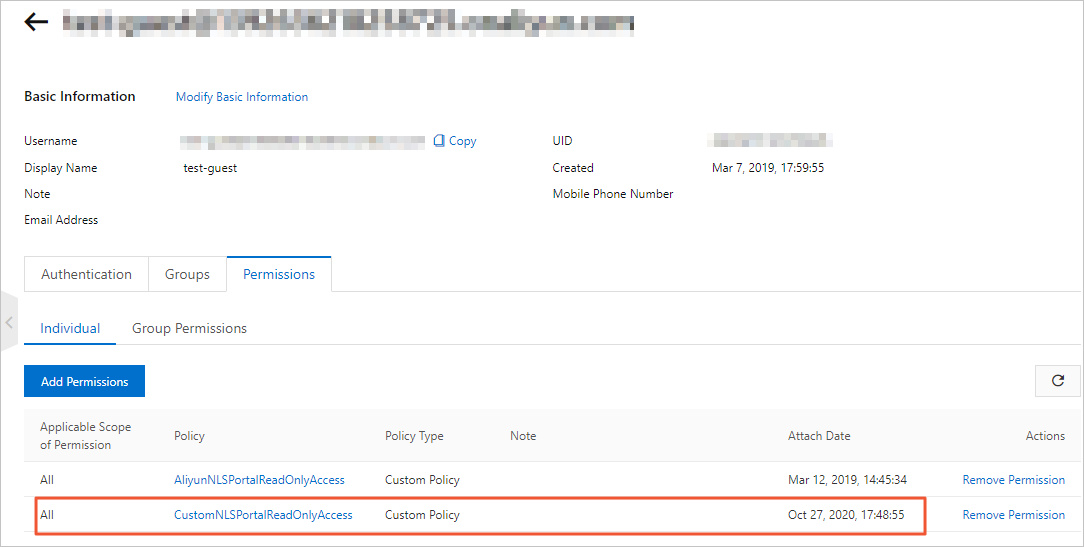This topic describes how to activate Intelligent Speech Interaction and grant service-related permissions to RAM users.
If you activated Intelligent Speech Interaction before July 5, 2018, you are using Intelligent Speech Interaction V1.0.
If you need to use the short sentence recognition and real-time speech recognition services of Intelligent Speech Interaction V2.0, follow the instructions to activate Intelligent Speech Interaction V2.0. In addition, upgrade your Intelligent Speech Interaction SDKs to V2.0.
Procedure
Go to the Alibaba Cloud international site (alibabacloud.com) and create an Alibaba Cloud account.
On the Intelligent Speech Interaction product page, click Activate Now.
On the page that appears, select Intelligent Speech Interaction services that you want to use, select Intelligent Speech Interaction V2.0 Service Level Agreement, and then click Activate Now.
NoteBy default, a free trial is available for Intelligent Speech Interaction services except for long-text-to-speech synthesis. Each Alibaba Cloud account can initiate a maximum of two concurrent service calls for free.
On the Security Management page, create an AccessKey pair that consists of an AccessKey ID and AccessKey secret for you to call Intelligent Speech Interaction services.
NoteThe AccessKey ID and AccessKey secret that you create belong to your Alibaba Cloud account. The AccessKey pair has access to all Intelligent Speech Interaction services that you activate. To improve security, we recommend that you do not use the AccessKey pair of your Alibaba Cloud account. Instead, you can create a RAM user in the Resource Access Management (RAM) console and use the AccessKey pair of the RAM user to call Intelligent Speech Interaction services.
Create RAM users
In the Alibaba Cloud Management Console, move the pointer over your profile picture in the upper-right corner and click Access Control to go to the RAM console. In the RAM console, create and manage RAM users.
For more information, see Create a RAM user.

Grant permissions to RAM users
In earlier versions, Intelligent Speech Interaction was not integrated with Alibaba Cloud RAM. However, to meet your business needs, you are allowed to use RAM users to access Intelligent Speech Interaction service resources under your Alibaba Cloud account by default.
To further safeguard the security of accessing Intelligent Speech Interaction service resources, we have integrated Intelligent Speech Interaction with Alibaba Cloud RAM. Only authorized RAM users are allowed to access Intelligent Speech Interaction service resources under your Alibaba Cloud account.
In the current version of Intelligent Speech Interaction, you must grant permissions to a RAM user before you can use services and resources as the RAM user. To grant permissions to a RAM user, perform the following steps:
Log on to the Alibaba Cloud Management Console by using your Alibaba Cloud account.
Move the pointer over your profile picture in the upper-right corner and click Access Control to go to the RAM console.
In the RAM console, choose Permissions > Policies.
RAM supports the following two types of policies: system policies that are managed by Alibaba Cloud and custom policies that are managed by your Alibaba Cloud account.
System policies
System policies are created by Alibaba Cloud. You can use but cannot modify system policies. On the Policies page, enter
nlsin the search box to view the predefined system policies for Intelligent Speech Interaction.
Policy
Meaning
Description
AliyunNLSFullAccess
Provides full access to Intelligent Speech Interaction.
This policy allows the specified RAM user to access the Intelligent Speech Interaction console and call all related API operations.
AliyunNLSReadOnlyAccess
Provides read-only access to Intelligent Speech Interaction.
This policy grants the specified RAM user read-only access to the Intelligent Speech Interaction console and all related API operations.
AliyunNLSSpeechServiceAccess
Provides access to Intelligent Speech Interaction services.
This policy allows the specified RAM user to call API operations that are related to Intelligent Speech Interaction services.
AliyunNLSSlpAccess
Provides access to the self-learning platform of Intelligent Speech Interaction.
This policy allows the specified RAM user to call the API operations that the self-learning platform of Intelligent Speech Interaction provides to manage hotwords and custom linguistic models.
Custom policies
You can create, update, and delete custom policies. You can use custom policies to grant RAM users access permissions on each API resource in a more flexible and fine-grained manner.
On the Policies page, click Create Policy.
On the Create Custom Policy page, specify Policy Name and Note and set Configuration Mode to Script. In the code editor that appears, edit the script and click OK.
Assume that you want to create a custom policy with read-only access to the Intelligent Speech Interaction console. You can set Policy Name to
CustomNLSPortalReadOnlyAccessand Note toCustom read-only console access policy. Then, you can enter the following script in the code editor:{ "Version": "1", "Statement": [ { "Effect": "Allow", "Action": [ "nls:Get*", "nls:List*", "nls:Verify*" ], "Resource": [ "acs:nls:*:*:portal/*" ] } ] }
In the script:
The value of the Effect parameter can be either Allow or Deny.
For the values of the Action and Resource parameters, see the system permission table at the end of this topic.
In the left-side navigation pane, choose Identities > Users. On the Users page, find the RAM user to which you want to grant permissions, and then click Add Permissions in the Actions column.
In the Add Permissions pane, click System Policy or Custom Policy in the Select Policy section. Find the policy that you want to attach to the RAM user, and click the policy to add it to the Selected section on the right.
Click OK.
Click the RAM user that you selected in Step c. On the page that appears, click Permissions. On the Individual tab, verify that the required permissions are granted to the RAM user.

System permission table
API operation
Action
Resource
CreateAsrVocab
nls:CreateAsrVocab
acs:nls:$regionid:$accountid:slp/vocab/*
DeleteAsrVocab
nls:DeleteAsrVocab
acs:nls:$regionid:$accountid:slp/vocab/$vocabId
DeleteVocab
nls:DeleteVocab
acs:nls:$regionid:$accountid:slp/vocab/$vocabId
GetAsrVocab
nls:GetAsrVocab
acs:nls:$regionid:$accountid:slp/vocab/$vocabId
ListAsrVocab
nls:ListAsrVocab
acs:nls:$regionid:$accountid:slp/vocab/*
UpdateAsrVocab
nls:UpdateAsrVocab
acs:nls:$regionid:$accountid:slp/vocab/$vocabId
AddDataToAsrLmModel
nls:AddDataToAsrLmModel
acs:nls:$regionid:$accountid:slp/lm/data/* acs:nls:$regionid:$accountid:slp/lm/model/$modelId
CreateAsrLmData
nls:CreateAsrLmData
acs:nls:$regionid:$accountid:slp/lm/data/*
CreateAsrLmModel
nls:CreateAsrLmModel
acs:nls:$regionid:$accountid:slp/lm/model/*
DeleteAsrLmData
nls:DeleteAsrLmData
acs:nls:$regionid:$accountid:slp/lm/data/$dataId
DeleteAsrLmModel
nls:DeleteAsrLmModel
acs:nls:$regionid:$accountid:slp/lm/model/$modolId
DeployAsrLmModel
nls:DeployAsrLmModel
acs:nls:$regionid:$accountid:slp/lm/model/$modolId
GetAsrLmData
nls:GetAsrLmData
acs:nls:$regionid:$accountid:slp/lm/data/$dataId
GetAsrLmModel
nls:GetAsrLmModel
acs:nls:$regionid:$accountid:slp/lm/model/$modolId
ListAsrLmData
nls:ListAsrLmData
acs:nls:$regionid:$accountid:slp/lm/data/*
ListAsrLmModel
nls:ListAsrLmModel
acs:nls:$regionid:$accountid:slp/lm/model/*
RemoveDataFromAsrLmModel
nls:RemoveDataFromAsrLmModel
acs:nls:$regionid:$accountid:slp/lm/data/$dataId acs:nls:$regionid:$accountid:slp/lm/model/$modolId
StopTrainAsrLmModel
nls:StopTrainAsrLmModel
acs:nls:$regionid:$accountid:slp/lm/model/$modolId
TrainAsrLmModel
nls:TrainAsrLmModel
acs:nls:$regionid:$accountid:slp/lm/model/$modolId
UndeployAsrLmModel
nls:UndeployAsrLmModel
acs:nls:$regionid:$accountid:slp/lm/model/$modolId
UpdateAsrLmData
nls:UpdateAsrLmData
acs:nls:$regionid:$accountid:slp/lm/data/$dataId
UpdateAsrLmModel
nls:UpdateAsrLmModel
acs:nls:$regionid:$accountid:slp/lm/model/$modolId
GetTaskResult
nls:GetTaskResult
acs:nls:$regionid:$accountid:filetrans/$taskId
SubmitTask
nls:SubmitTask
acs:nls:$regionid:$accountid:filetrans/*
CreateToken
nls:CreateToken
acs:nls:$regionid:$accountid:meta/*
What to do next
Log on to the Intelligent Speech Interaction console and create a project.